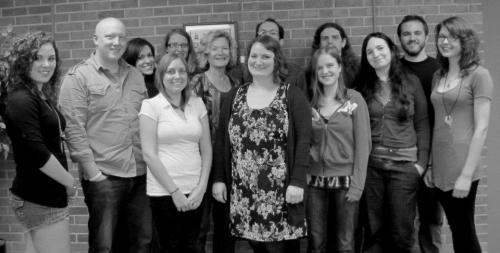2011 Virginia Butts Sturm Workshop with Carol Frost: The Week of Coffee and Wine
by Christina Seymour

I believe I speak for most of the Virginia Butts Sturm Workshop attendees when I say that Carol Frost is equally brilliant and intimidating. The week started off with a reading by Carol from her book Honeycomb that carries extended metaphors of bees, bears, honey, and roses throughout poems that explore the meaning of her mother’s Alzheimer’s. Although the book is more personal than her others, Carol still employs her knack for artful line and form, including the use of the enigmatic double colon (of which Carol whispered the meaning one magical night over microbrews and wine).
Our workshop commenced with a gathering in the seemingly haunted Bluestone Room of the Mountainlair—a much prettier room than G10 Colson, complete with stained glass art, a loveseat and coffee table area, a wooden conference table to be envied, and metal, echo-ey sounds that seemed to emanate from a glass display case of pottery. Indeed, this was the perfect backdrop for our poetry workshop. We began by discussing the conventions of free verse through Carol’s thought-provoking lens. For example, Carol explained that to achieve “syntactic agility” the artist must “take the sentence and drape it across lines.” When discussing combining line strategies, Carol taught us that only after we master all forms can we begin to invent, that if we learn psychology and botany we can show how the mind works through “unstoppably beautiful images,” that lines should “teach us how to read the poem and show what it is about,” and finally that poems shouldn’t fool, shouldn’t be sentimental, and shouldn’t simply “show the writer’s chops.” And this was our discussion of just one of the 15 conventions.
In workshopping, Carol asked both the writer and another student to read a poem aloud. Then, when Carol prompted us to comment, we would fall quiet perhaps in nervousness or, maybe more accurately, in respect for her exacting and aha-inducing critiques. Indeed, Carol did not let any poem shallow in meaning go uncriticized. If no relevant issue or obsession was addressed, if with every possible arrangement of line and with every possible pronoun, nothing changed about a poem, Carol suggested, maybe this poem was not worth writing. She also guided her critiques with her aesthetic: a balance of clarity and mystery. We students could conceptualize this aesthetic, but we often danced around its application, wondering, “Yes, there is something unclear in this poem, but what is it? The stanza breaks? The abstractions?” while Carol would pointedly suggest: “Well, the lines seem a bit choppy, don’t they?” or “the speaker seems to be in the wrong person.” AHA! Not only did Carol direct us to the very moment in the poem that caused us confusion or disinterest, she also pulled exercises from her back pocket. For example, within the first few minutes of our first class she instructed us to write a poem, scan it, and repeat the same rhythm in different words.
Carol’s lulling, experience-laden, and craft-focused monologues in which she stepped from one thought to another with ease were not only enthralling in workshop but also during after-workshop dinners and drinks. After the first class, she accompanied some students to the deck of the Morgantown Brewing Company. The strange juxtaposition of Carol’s never-straining voice with an eclectic mix of contemporary hip hop and popular classic rock afforded for interesting conversation as well as a lingering feeling of “THIS is grad school”—and that was not just sewage scent from the river or the 80 Schilling Ale seeping into our brains. In this atmosphere, she told us about interactions with her own students, her less censored theories of poetry, meeting Salvador Dali (yes, meeting Salvador Dali), and the meaning behind the infamous double colon.
Ultimately, my busy but writing-filled week of the Sturm Workshop was kind of like an initiation ceremony into MFA-hood. Devoting three consecutive evenings to hours of poetry, free from the distractions of teaching, the internet, and dirty dishes, I was pushed far enough out of my comfort zone to feel insecure about my work but also on the verge of finding an answer, of making some change that would throw my work into a new realm of being. Carol’s voice lingered just enough for me to keep writing through the evenings, even after the after-workshop drinks. In reply to a question many of us Sturm students have been asking all semester, “how much should we resolve our poems for our readers,” Carol answered, “readers supply that an egg will fall if we show one in mid-air.” Carol Frost, an equal mix of clarity and mystery.
To learn more about the Virginia Butts Sturm Writer in Residence Program click here.

 Feed
Feed
Comments disabled
Comments have been disabled for this article.